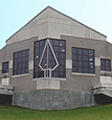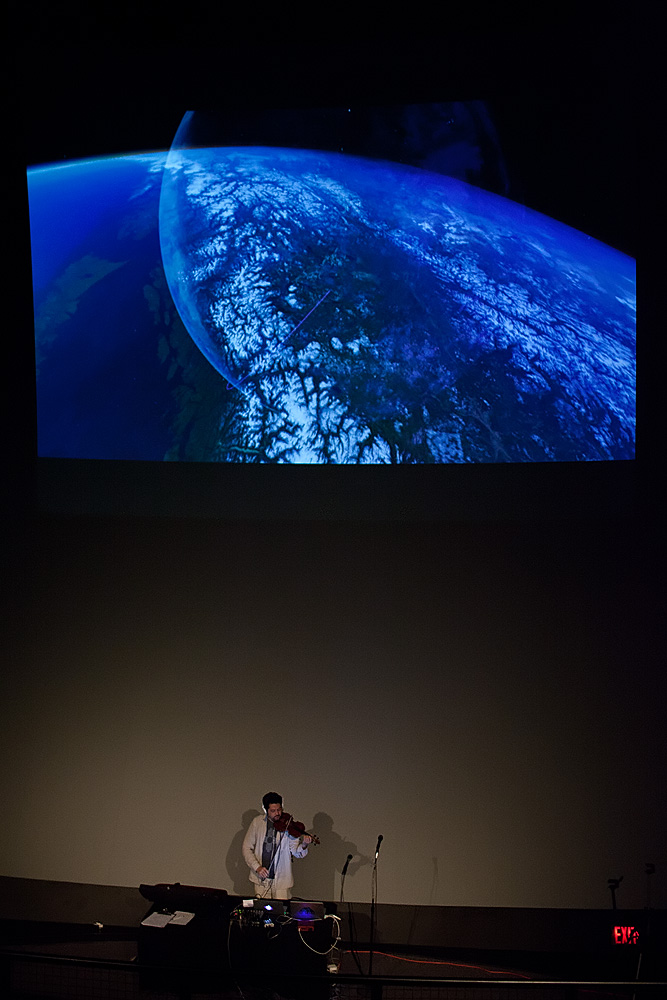
Syracuse, NY- Curriculum developers at the MOST had an idea that they wanted to share with the Onondaga Nation School. They wanted to unite award winning composer, filmmaker and violinist Kenji Williams, NASA, and the Onondaga Nation School to share Kenji’s latest vision the Beautiful Earth Project, Bella Gaia.
The day began with Larry Leathman welcoming the school to the MOST’s theatre. He explained that he has been working on this project from California and that he was thrilled to see the faces of the children from the Onondaga Nation to see the show.
Our own Heath Hill followed with the Ganoñhéñ•nyoñ’ or Thanks Giving Address. Heath interpreted the Address and how important it was for all of us to continue to respect our Mother Earth. “Taking care of Mother Earth is an important duty given to us by the Creator that we all must continue to do everyday.” said Heath.
Kenji Williams then entered onto the stage and thanked Heath for the Thanks Giving Address. The same ideas expressed in the Thanks Giving Address are the ideas that helped him create, Bella Gaia. Kenji explained the inspiration for the project. He was traveling in a plane sitting next to and was talking to an astronaut who had just returned from a tour on the International Space Station. Kenji recalled asking the astronaut about the experience.
“It changed me forever,” The astronaut said. “Seeing our earth so beautiful and so fragile changed my everyday behavior. On Earth, you think we have a mountain of air, we don’t.”
Kenji then began wonder, “How can we have the same experience as the astronaut without traveling into space?”
From that thought, a collaboration with NASA grew and grew until Bella Gaia was created and shown to large audiences in Japan, Europe and the United States.
Kenji’s project Bella Gaia led us through the galaxies and our solar system to our planet with beautiful imagery provided by NASA as he performed on his violin.
Audrey for the 3rd grade commented, “The violin sounded so beautiful.”
“He was very talented.” added Tresah also from the 3rd grade.
The NASA imagery also illustrated an important point, that our world is full of beauty as well as danger. Kenji showed us the beautiful rivers of the Nile, the temples in Japan, and the lands of the Haudenosaunee. Bella Gaia also showed us images of our warming oceans, the forest fires in South America, the melting ice shelf, and the loss of our forests world wide.
“I liked it (Bella Gaia). It was all about our earth.” commented Paul of the 3rd grade.
Our next presenter was Thornsten Marcus, a scientist from NASA. Thornsten explained how NASA is able to study the earth from space.
Thornsten states, “The many satellites we send into space send information back to us so that we can monitor what is going on all over the world.”
From those satellites the scientists have been able to monitor the changes in the earth’s climate in just the past few years. From this information, Thornsten is able to travel to specific parts of the world to study the changes in the arctic ice shown in the satellite pictures.
Closing out the presentations in the theatre was Jim Rock. Jim is also with NASA but also a Lakota from Minneapolis. He explained how NASA is beginning to use the knowledge of our people to expand their knowledge of the stars.
“Our people come from the Seven Star Nations in the sky.” Jim explained as he talked about the origins of his people. “Now NASA is exploring the different elements that are in our solar system that may also hold the beginnings of life.”
After a delicious apple snack, we finished the day conducting experiments with the scientists from NASA. There we explored the importance of the interaction of cold and warm water and the salinity of water. After  our experiments we concluded that cold water is heavier than warm water and salty water is heaver than fresh water. Thornsten explained the importance of this experiment.
our experiments we concluded that cold water is heavier than warm water and salty water is heaver than fresh water. Thornsten explained the importance of this experiment.
 our experiments we concluded that cold water is heavier than warm water and salty water is heaver than fresh water. Thornsten explained the importance of this experiment.
our experiments we concluded that cold water is heavier than warm water and salty water is heaver than fresh water. Thornsten explained the importance of this experiment.“Bella Gaia showed show the oceans move. Once the current reached the polar regions the water sank allowing the ocean water to act like a pump, pulling up the warm water and pushing down the cold. If we loose more and more of our ice caps, the pump will stop working.”
He continued, “Clouds control weather, but the oceans control our climate. Once the pump stops, our climate will change dramatically.”
Fifth grader Jaden stated, “I really liked doing the science experiments.”
We ended our day in a sharing circle. We were very excited to have been invited to the MOST for such a great event.
Asah of the 5th grade wrapped up the day, “I loved the pictures. The music was awesome. It was a great day.”











